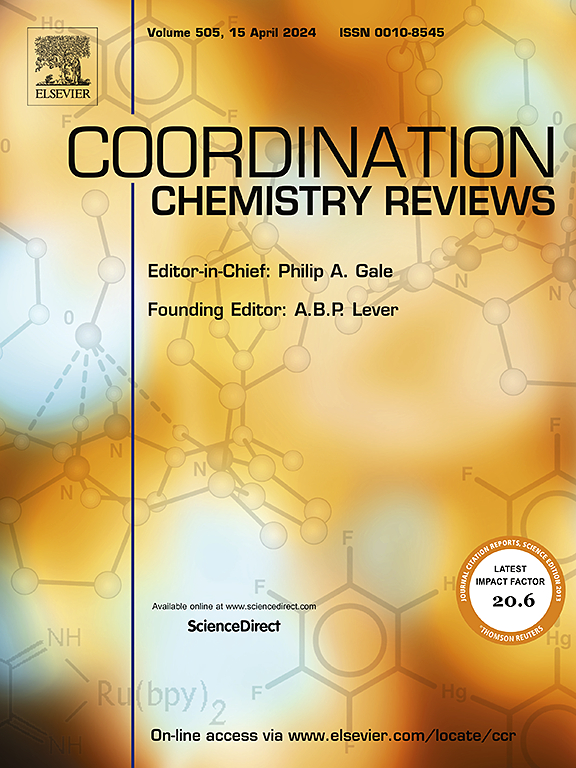Approaching through the chronicles of species with low-valent silicon and their transition metal complexes: Structure, bonding and potential catalytic applications
IF 20.3
1区 化学
Q1 CHEMISTRY, INORGANIC & NUCLEAR
引用次数: 0
Abstract
Compounds with low-valent silicon characterized by an oxidation state lower than +IV (the most stable oxidation state for silicon) represent one of the fascinating and rapidly emerging fields of research in main-group chemistry. The primary challenge associated with the research involving compounds with low-valent silicon is their synthesis and isolation due to their high reactivity and tendency to attain the most stable oxidation state. Despite the challenges associated with compounds of low-valent silicon, their study is crucial as their unique reactivity can be explored for various catalytic transformations. In addition, compounds of low-valent silicon can serve as ligands to transition metals, which can lead to the formation of metal complexes that may have potential for catalytic applications. The review commences with the highlights of the milestone discoveries in the field of compounds with low-valent silicon. The next section of the review discusses the structure and bonding properties of different classes of compounds with low-valent silicon according to their oxidation state [+II (silylene, disilene, disilyne and silyliumylidene ion) and 0 (silylone)]. The subsequent section provides insights into different binding modes of compounds with low-valent silicon to transition metals. A detailed emphasis is given on some notable examples of transition metal complexes supported compounds with low-valent silicon as ligands, focusing on their synthesis, characterization, and potential catalytic applications.

通过低价硅及其过渡金属配合物的物种编年史:结构、键和潜在的催化应用
以氧化态低于+IV(硅最稳定的氧化态)为特征的低价硅化合物代表了主基团化学中引人入胜且迅速兴起的研究领域之一。低价硅化合物的研究面临的主要挑战是它们的合成和分离,因为它们具有较高的反应活性和达到最稳定氧化态的倾向。尽管与低价硅化合物相关的挑战,他们的研究是至关重要的,因为他们独特的反应性可以探索各种催化转化。此外,低价硅化合物可以作为过渡金属的配体,从而形成可能具有催化应用潜力的金属配合物。本文首先回顾了在低价硅化合物领域的里程碑式发现。下一节将根据氧化态[+II(硅烯、二烯、二苯乙烯和硅六偏二烯离子)和0(硅酮)]讨论不同类型的低价硅化合物的结构和键合性能。下一节将深入探讨含有低价硅的化合物与过渡金属的不同结合模式。详细介绍了以低价硅为配体的过渡金属配合物的一些著名例子,重点介绍了它们的合成、表征和潜在的催化应用。
本文章由计算机程序翻译,如有差异,请以英文原文为准。
求助全文
约1分钟内获得全文
求助全文
来源期刊

Coordination Chemistry Reviews
化学-无机化学与核化学
CiteScore
34.30
自引率
5.30%
发文量
457
审稿时长
54 days
期刊介绍:
Coordination Chemistry Reviews offers rapid publication of review articles on current and significant topics in coordination chemistry, encompassing organometallic, supramolecular, theoretical, and bioinorganic chemistry. It also covers catalysis, materials chemistry, and metal-organic frameworks from a coordination chemistry perspective. Reviews summarize recent developments or discuss specific techniques, welcoming contributions from both established and emerging researchers.
The journal releases special issues on timely subjects, including those featuring contributions from specific regions or conferences. Occasional full-length book articles are also featured. Additionally, special volumes cover annual reviews of main group chemistry, transition metal group chemistry, and organometallic chemistry. These comprehensive reviews are vital resources for those engaged in coordination chemistry, further establishing Coordination Chemistry Reviews as a hub for insightful surveys in inorganic and physical inorganic chemistry.
 求助内容:
求助内容: 应助结果提醒方式:
应助结果提醒方式:


